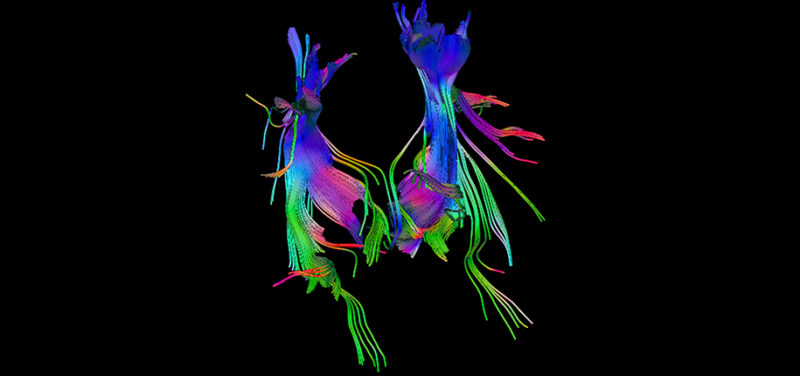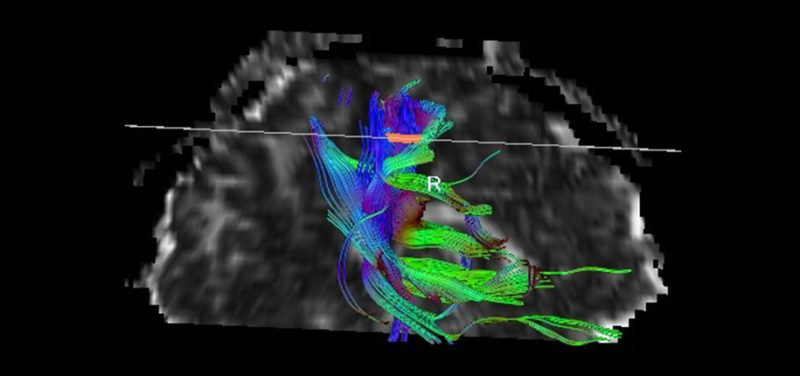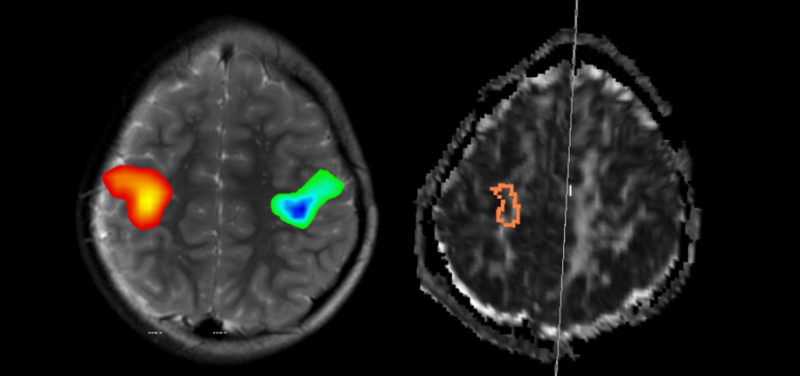
Considering magnetic resonance imaging (MRI) has been around since the late 1970’s, most people have seen, heard about, or even experienced an MRI for themselves. It is not, however, customary to have much information about functional MRIs (fMRI) and its combination of still imaging with physical moments and cognitive exercises. In an attempt to better understand such amazing technology, we have met up with Dr. Blaise Jones, the Chief of Neuroradiology here at Cincinnati Children’s, to get the scoop on fMRIs.
 Image: fMRI Sagittal (side profile) image of brain with the fibers carrying motor control.
Image: fMRI Sagittal (side profile) image of brain with the fibers carrying motor control.
Q: Dr. Jones, we sometimes have families call and ask us about functional MR imaging. Can you explain how that works and what it is used for?
A: Functional MRI, or fMRI, is a type of MRI exam that looks at what areas of the brain are activated when doing simple tasks, like tapping your fingers or listening to a story. Although we have a general idea of where these stimulated parts of the brain are located, they can vary from patient to patient, especially if there is an abnormality in the brain that may cause these locations to move. By doing an fMRI study, we can see exactly where these areas are within each individual and create a “map” of their brain.
Q: What is the purpose of making this “map” of the brain?
A: We do these exams for patients who are going to have brain surgery. For example, if a child needs to have surgery to remove a tumor that is in the part of the brain that usually controls the right hand, we can map out exactly how close the tumor is to the “hand control” area. With this information, the surgeon is better able to remove the tumor without hurting any hand control. The pictures can even be transmitted to the operating room to guide the surgeon, just like a GPS can guide you driving your car.
 Image: The image on the left was obtained while the patient took turns tapping right fingers and then left fingers. When the patient tapped their right fingers, the activated parts of the brain showed up as blue-green. When the patient tapped their left fingers, the activated parts of the brain showed up as red. Because the activation for the left hand is on the same side of the brain as the tumor, there was a risk of paralysis with surgery. The image on the right shows the area containing the fibers that carry the signals controlling the left hand. The fibers could then be mapped out to show the safest approach to the tumor.
Image: The image on the left was obtained while the patient took turns tapping right fingers and then left fingers. When the patient tapped their right fingers, the activated parts of the brain showed up as blue-green. When the patient tapped their left fingers, the activated parts of the brain showed up as red. Because the activation for the left hand is on the same side of the brain as the tumor, there was a risk of paralysis with surgery. The image on the right shows the area containing the fibers that carry the signals controlling the left hand. The fibers could then be mapped out to show the safest approach to the tumor.
Q: What sort of areas can you map out? Can you tell where somebody’s personality is located?
A: Personality would be very hard to capture, because there are so many parts of the brain that contribute to it, and we don’t have a good definition of what a personality actually is exactly. But we can map out the parts of the brain that move your fingers and toes, and where you understand and create language.
Q: Some families have read about fMR being used for children with ADHD or dyslexia. Do we do fMR exams for these conditions?
A: Researchers use fMRI to study things like ADHD and dyslexia in order to understand how people with these conditions process language differently than people without them. But the information they get from fMRI does not make the diagnosis, and it doesn’t change the plan for treatment. So fMRI is not used for diagnosing and treating these conditions; it’s only used in research on them.
Related article: What Is Advanced Neuroimaging?
Although the questions could have continued we had to let Dr. Jones get back to changing the outcome. Through his specialized talents and information gained through fMRI, we consistently strive to offer the best care possible.
Contributed by Dr. Blaise V. Jones and edited by Tony Dandino, SPEC-MR QUALITY.
